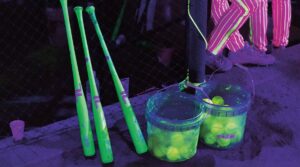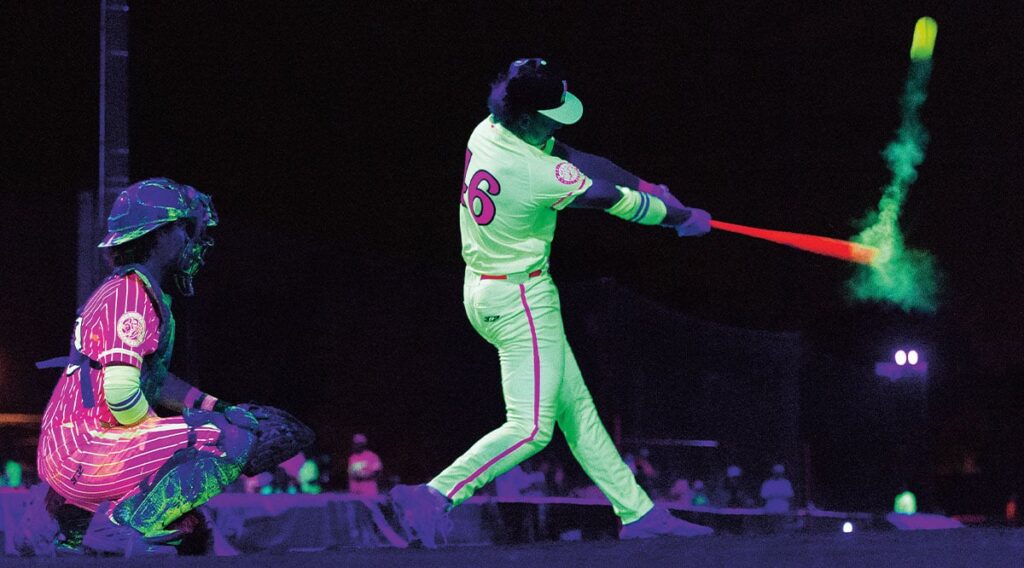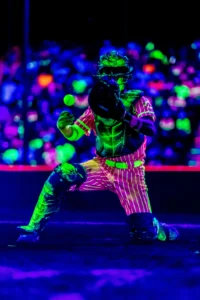
In an age where screens dominate after sunset and community sports struggle to compete with on-demand entertainment, a remarkable trend is illuminating diamonds across America—literally. Glow-in-the-dark baseball, once a quirky novelty or camp activity, is now surging as a legitimate cultural phenomenon. From youth leagues to recreational adult tournaments, this electrified version of America’s pastime is bringing a whole new light—UV light, to be precise—to the sport.
What was once a fun nighttime alternative at summer camps has evolved into a carefully crafted experience that blends athleticism with theatricality. As glowing balls arc through the sky and players streak across the bases in phosphorescent cleats and UV-reactive uniforms, it becomes immediately clear: this is more than just baseball after dark—it’s an entirely new way to play, to watch, and to gather.
Origins: From Summer Camp to Subculture
The idea of nighttime or glow-in-the-dark sports is not new. The first widespread experiments with luminescent sporting took place in youth camp programs during the late 1980s and early 1990s. Baseball, however, proved a bit tricky. Unlike basketball or dodgeball, it required significant equipment modifications—balls needed to be trackable in flight, bats needed to be both safe and visible, and fields needed ambient lighting without flooding visibility.
Enter UV-reactive materials and LED technology. Around 2010, innovators in sporting goods began experimenting with phosphorescent polymers and battery-powered accessories. It didn’t take long for smaller communities—especially in the American South and Midwest—to begin organizing glow-in-the-dark baseball events. These early games weren’t just about fun; they were about inclusion, imagination, and reintroducing lapsed players to a game that had grown too rigid or inaccessible.
What started as a gimmick has now found legs. In 2024, USA Today ran a feature on Midnight Diamonds, a youth baseball nonprofit in Arizona that hosts night games lit entirely with blacklights. Since then, hundreds of similar organizations have sprung up nationwide.
Aesthetics Meets Athletics: The Allure of Nightball
The appeal of glow-in-the-dark baseball is both visceral and symbolic. Visually, it’s stunning. Bats painted with UV streaks swing through a galaxy of firefly dust as balls explode in neon trails toward phosphorescent gloves. Uniforms light up in patterns only visible under ultraviolet light, adding a layer of style—and unity—to team dynamics. Even the bases glow, guiding runners like constellations across an inky field.
But beneath the spectacle lies something more intimate: a sport remade for the nocturnal spirit. Glow-in-the-dark baseball offers a reprieve from the harshness of summer heat, a way for communities to gather after traditional hours, and a more forgiving, joyful form of competition. The pressure often associated with daylight games—parental intensity, school recruiting, hard-scouted rivalries—is replaced by music, cheering, and a collective sense of wonder.
In this sense, glow baseball functions as a kind of community theater, combining elements of sport with performance and ritual. It invites players to dress differently, move differently, even think differently. A glow game is not just something you play; it’s something you remember.
Who’s Playing—and Why
Though youth leagues remain the backbone of the movement, adult participation is exploding. Local parks departments from Portland to Tampa now host biweekly glow tournaments that bring together amateur players of all ages. Couples on dates, parents reliving their Little League years, office teams letting off steam—nightball, as it’s colloquially known, has become a casual cultural equalizer.
For teenagers, especially, the appeal is electric. After a long school day or summer job, the idea of playing ball under starlight, surrounded by friends, beats another evening indoors. And for those who may have felt alienated by the intensity of competitive travel ball culture, glow games offer a low-stakes, high-reward alternative.
“We see a lot of kids who quit baseball around middle school coming back for this,” says Erica Linwood, a high school coach and organizer for the Minnesota Nightlights League. “They’re not burned out here. They’re just having fun again.”
Accessibility is another key driver. With many leagues requiring only modest lighting infrastructure and a few glow modifications to gear, it’s often more affordable than traditional after-school sports. Communities short on field lighting have embraced it as a cost-effective evening programming solution, bringing people together long after sunset.
Equipment and Innovation
The gear for glow-in-the-dark baseball is advancing rapidly. What began with glow sticks taped to bats has now become a minor industry. Specialized companies offer full glow kits: LED baseballs with motion-activated cores, UV-reactive jerseys made from recycled fabric, light-diffusing helmets, and even bases embedded with solar-charged strips.
A major innovation came in 2023 when Glowtek Athletics, a startup based in Austin, patented a ball that holds charge for a full nine innings, reacting to swings with dynamic bursts of color. This design reduced the need for constant ball switching, making competitive matches feasible without constant resets.
Retailers have taken note. Major outlets like Dick’s Sporting Goods and Academy now carry entry-level glow packs. Even Nike and Easton have teased prototypes for neon-ready footwear and bats designed for UV responsiveness.
And where innovation goes, media follows. TikTok compilations of glow baseball plays have racked up millions of views. YouTube creators produce mini-documentaries on community leagues. ESPN2, always on the hunt for offbeat sports content, aired a pilot “Nightball Showdown” in April 2025.
Literature and Cultural Symbolism
Baseball has always thrived on metaphor. It’s the great American novel played out on grass and clay—narrative arcs, flawed heroes, triumph, defeat, redemption. In The Natural, Bernard Malamud makes the sport mythic. In Field of Dreams, it becomes sacred. With glow-in-the-dark baseball, the metaphor shifts. We move from daytime nostalgia to nighttime necessity—from sun-drenched Americana to a kind of lucid dreaming of the national pastime.
Writers have begun to explore this. In online journals and indie zines, essays trace the poetic inversion of this game in the dark. “We play baseball at night not to escape the past,” wrote one author in The Ringer, “but to imagine a new one—where our mistakes are less visible, and our joy glows harder.”
It’s easy to see why this resonates. In a post-pandemic world marked by anxiety, fractured attention, and social retreat, glow baseball represents reconnection through reframing. It asks us not to abandon tradition, but to reinterpret it. To see in the glow what we missed in the sun.
The Future of Glow Baseball
What’s next for this glowing movement? Schools are beginning to adopt modified nightball curriculums for PE programs. Brands are connecting with leagues for limited-run gear drops. Independent creators are crafting mini-documentaries that celebrate glow baseball’s emotional depth—stories of fathers and daughters finding new rituals, of neighborhoods reclaiming their diamonds from neglect.
Some cities are already considering permanent UV infrastructure, allowing year-round access to glow sports. Meanwhile, nonprofits are using the format to reach underrepresented communities with nighttime youth engagement. Glow baseball’s low barrier to entry and communal focus make it an ideal tool for community healing and celebration.
And perhaps most interestingly, storytellers are taking notice. Screenwriters and novelists are beginning to see the metaphorical potential of this surreal, luminous world. It’s only a matter of time before we see a coming-of-age film set entirely on a glow-in-the-dark baseball field—where mistakes, like base paths, are only visible under the right kind of light.
Impression
Glow-in-the-dark baseball is more than a trend—it’s a mirror. It reflects our shifting relationship to sport, community, and time itself. It offers joy without pressure, performance without ego, and nostalgia without decay. As more fields glow and more players step into the night, this version of baseball promises not only play, but renewal.
In a country wrestling with light and dark—politically, culturally, personally—there’s something deeply poetic about running bases that shine in the dark. Something redemptive in swinging at a glowing pitch and sending it arching into stars. Glow baseball doesn’t change the game. It reframes it.
And sometimes, a new frame is all it takes to fall in love again.
No comments yet.









